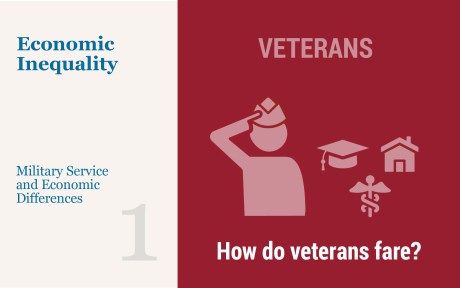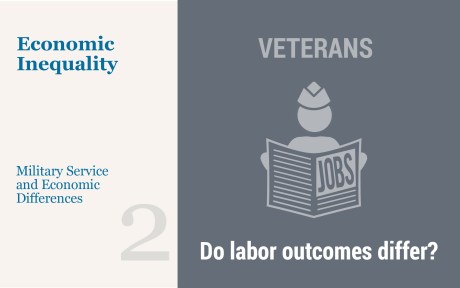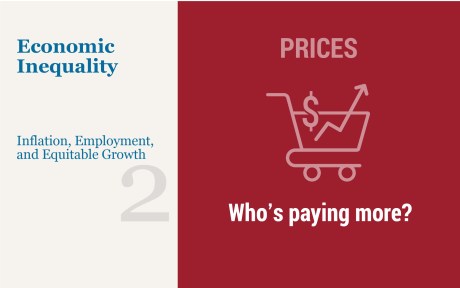
Veterans are an understudied group that forms an important part of the fabric of American society and that constitutes a significant segment of the population. In the first post of this two-part series, we will investigate how the outcomes of veteran men–in educational attainment, health, and housing–differ from those of comparable men who did not serve in the military. Looking only at men, for reasons described below, we find that relative to nonveteran men with a high school degree and a similar distribution of demographic and geographic characteristics, veterans are 7 percentage points less likely to have a college degree and are over 50 percent more likely to experience a disability. Veterans are also somewhat likelier to rent a home than to own and, as renters, pay a lower average rent, suggesting they experience lower quality housing or live in worse neighborhoods.
Service in the military may bring both economic advantages and economic disadvantages. It represents a commitment of time away from classroom education or civilian employment during the very years when many people begin their careers. It also carries with it the threat of injury or severe mental stress. However, military service may also bring advantages, such as opportunities to learn new technical and interpersonal skills, access to health insurance through the Veterans’ Administration, or subsidies to higher education through the G.I. Bill.
The Data Set
We use the 2019 five-year American Community Survey (ACS), the last one before the onset of the COVID-19 pandemic, to compute average outcomes for male veterans and nonveterans aged between 25 and 69. This cut of the data has us looking at the population of veterans who served when enlistment in the armed forces was voluntary, after the end of the draft in 1971. It is a challenge to construct a comparison group since veterans differ from nonveterans among many dimensions. For example, veterans are overwhelmingly likely to be male high school graduates as the military typically requires a high school degree for service. Veterans are older, with enlistment rates drifting down over time. They are also more likely to be native-born and white, and more likely to have been born in the South and the Midwest than in the Northeast and the West.
Therefore, for a more comparable group for veterans, we take the population of nonveteran male high school graduates and weight them to match the age, racial, ethnic, immigrant and geographic distributions of veterans. Following a previous paper, we use as weights the fractions of the male high school graduate population in each age, race, origin, and geography category who are veterans. We will refer to this control group as “comparable nonveterans” for the rest of the series. While our methodology does not remove all sources of differences between veterans and “reweighted” nonveterans (for example, the veterans may differ from nonveterans in other aspects of their background, or in unobservables such as personality or interests, for which there is no data in the ACS), it avoids the most obvious sources of noncomparability between them and allows us to focus on the consequences of being a veteran.
Differing Outcomes in Education, Health, and Housing
Despite having access to the benefits of the G.I. Bill, veterans are less likely than comparable nonveterans to pursue further education after high school. We see in the chart below that while 34 percent of male high school graduates who are not veterans obtain a bachelor’s degree or higher, only 27 percent of veterans do so. Veterans are also less likely to end their education with a bachelor’s degree (17 percent vs. 22 percent) and to go on to obtain an advanced degree (10 percent vs. 12 percent) than nonveterans. These differences may be due to the direct effects of military service (including spending a number of critical years for education in the military), as well as to unobserved differences between veterans and nonveterans that are not captured by their age, ethnic, and geographic background.
Veterans Are Less Likely to Hold a Bachelor’s or Advanced Degree
Percent
On the health front, we see in the panel chart below that while the percentage of veterans that is uninsured is substantially lower than nonveterans, veterans are over 50 percent more likely to have a disability, with the odds rising even higher for some specific disabilities. Thanks to being eligible for additional forms of health insurance, only 6 percent of veterans are uninsured, compared with 11 percent of comparable nonveterans (left panel). However, despite this coverage, the health of veterans, at least as measured by the presence of disabilities, is poorer (right panel). Veterans are also half again as likely to be disabled, with 19 percent of veterans having a disability as opposed to 12 percent of comparable nonveterans. Veterans are more than twice as likely to have a hearing disability (7 percent vs. 3 percent) and nearly twice as likely to have a sensory disability (9 percent vs. 5 percent). Given that people serving in the armed forces usually have to pass a medical review, disparities between veterans and nonveterans in their disability rate likely emerge either directly from military service or from differences in what veterans and comparable nonveterans do after the veterans leave the military.
Veterans Are More Likely to Have Health Insurance, Yet Are More Likely to Be Disabled
Percent
Percent
Sources: American Community Survey; authors’ calculations.
This analysis also sheds light on the housing situation of veterans and nonveterans who either own or rent. (We don’t consider homelessness; while veteran homelessness is a critical policy concern, there are potential data gaps since the ACS methodology of finding respondents likely undersamples the homeless). In the panel chart below, we see that the renting status of veterans and nonveterans differs little (left panel), standing in contrast to the educational and health differences identified above. Veterans are somewhat more likely to rent than nonveterans are, but the homeownership rate among veterans is 70 percent, just one percentage point less than that of comparable nonveterans. However, veterans may be consuming housing of lower quality. Veterans who are renters pay about 6 percent less in rent than comparable nonveteran renters, suggesting that they rent housing with fewer amenities or in worse neighborhoods (right panel); the same observation about housing quality may apply to veteran homeowners.
Veterans Are Slightly More Likely to Rent, and Rent Less Expensive Housing
Home Ownership
Percent
Average Rent
U.S. dollars
Sources: American Community Survey; authors’ calculations.
To conclude, we see that, when making the comparison with nonveterans who are demographically similar to veterans, veterans have lower education attainment and a greater prevalence of disabilities than nonveterans. The data also suggest veterans are in somewhat worse housing situations. In the second post of this series, we will investigate differences in earnings and labor market outcomes of veterans and nonveterans, and how these differences may be explained by their disparities in terms of education and health. More broadly, we will continue to track data relevant to economic outcomes by race/ethnicity, gender, income, age, veteran status, and geography in a new monthly data product, Equitable Growth Indicators (EGI). Visit our web feature for charts and brief takeaways on disparities in people’s experience of inflation, earnings, employment, and consumer spending.

Rajashri Chakrabarti is the head of Equitable Growth Studies in the Federal Reserve Bank of New York’s Research and Statistics Group.

Dan Garcia is a research analyst in the Federal Reserve Bank of New York’s Research and Statistics Group.

Maxim Pinkovskiy is an economic research advisor in Equitable Growth Studies in the Federal Reserve Bank of New York’s Research and Statistics Group.
How to cite this post:
Rajashri Chakrabarti, Dan Garcia, and Maxim Pinkovskiy, “Do Veterans Face Disparities in Higher Education, Health, and Housing?,” Federal Reserve Bank of New York Liberty Street Economics, May 25, 2023, https://libertystreeteconomics.newyorkfed.org/2023/05/do-veterans-face-disparities-in-higher-education-health-and-housing/
BibTeX: View |
Disclaimer
The views expressed in this post are those of the author(s) and do not necessarily reflect the position of the Federal Reserve Bank of New York or the Federal Reserve System. Any errors or omissions are the responsibility of the author(s).













 RSS Feed
RSS Feed Follow Liberty Street Economics
Follow Liberty Street Economics
Do you folks do any surveys on retired Fed Employees whom served in the Military. You may get some interesting answers. I myself joined the Boston Fed in October of 1967. Cash Operations my entire time between the Boston and New York Feds. Then I joined the Air Force and served our country from August of 69 to August of 73. Returned to FRB Boston right away. Because of family situations I transferred from Boston to NY, back to Boston then back to NY. I retired out of EROC. November 1st of 2011. One week into my 45th year.